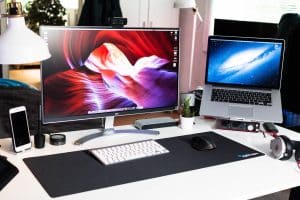Ergonomics is a science that focuses on creating a work environment that is designed to improve comfort and efficiency. When it comes to computer monitors, ergonomics plays an important role in ensuring that users are comfortable, productive, and free from any physical strain or injury.
To that end, an ergonomic monitor is a monitor that has been designed to promote user comfort and reduce the risk of physical strain or injury.
What Are the Benefits of an Ergonomic Monitor?
Ergonomic monitors are designed to reduce the amount of strain on the user’s eyes, neck, back, and wrists. The monitor is adjustable, allowing the user to customize it to their specific needs. This includes the ability to adjust the height, tilt, and swivel of the monitor. This is important to prevent eye strain, as the user can adjust the monitor to the right position for their eyes.
Ergonomic monitors also come with features that reduce the risk of injury due to prolonged use. This includes features such as adjustable stands to reduce strain on the wrists or adjustable armrests to reduce strain on the neck and back. Additionally, many ergonomic monitors come with special features such as blue light reduction, which helps to reduce eyestrain, and anti-glare screens, which can reduce reflections and glare.
How Do I Pick the Right Ergonomic Monitor?
When choosing an ergonomic monitor, it’s important to consider the size, position, and resolution of the display. The size of the monitor should be based on your viewing distance, as well as the size of the desk. Ideally, the monitor should be positioned at a distance of 20 to 40 inches from your eyes, and the top of the monitor should be at the same level as your eyes when you’re sitting in a comfortable, upright position. The resolution of the monitor should be high enough to provide clear and crisp images but not so high that it causes eye strain.
When it comes to features, look for a monitor with adjustable height, tilt, and swivel capability. This will allow you to customize the monitor to your particular posture and position. Look for a monitor with a wide viewing angle, so you can easily view the screen from different angles, and adjustable brightness and contrast settings, so you can adjust the display for maximum comfort.
Other ergonomic features to look for include a flicker-free display, an anti-glare coating, and an anti-reflective surface. Flicker-free displays reduce eye strain and fatigue, while anti-glare and anti-reflective coatings help reduce glare and reflections from windows and other surfaces. Finally, look for a monitor with a low blue light setting. Blue light has been shown to cause eye strain and fatigue, and a low blue light setting helps reduce this effect.
Conclusion
Ultimately, the best monitor for you is one that meets your viewing needs and fits into your budget. When shopping for an ergonomic monitor, take the time to do your research and find a monitor that fits your needs and your budget. With the right ergonomic monitor, you can help reduce neck, shoulder, and eye strain and create a comfortable and productive work environment!
TechnoQia offers a variety of blog posts revolving around technology to help you understand the electronics around us and how you can elevate your lifestyle with them. For more technology reviews, check out our other articles!





